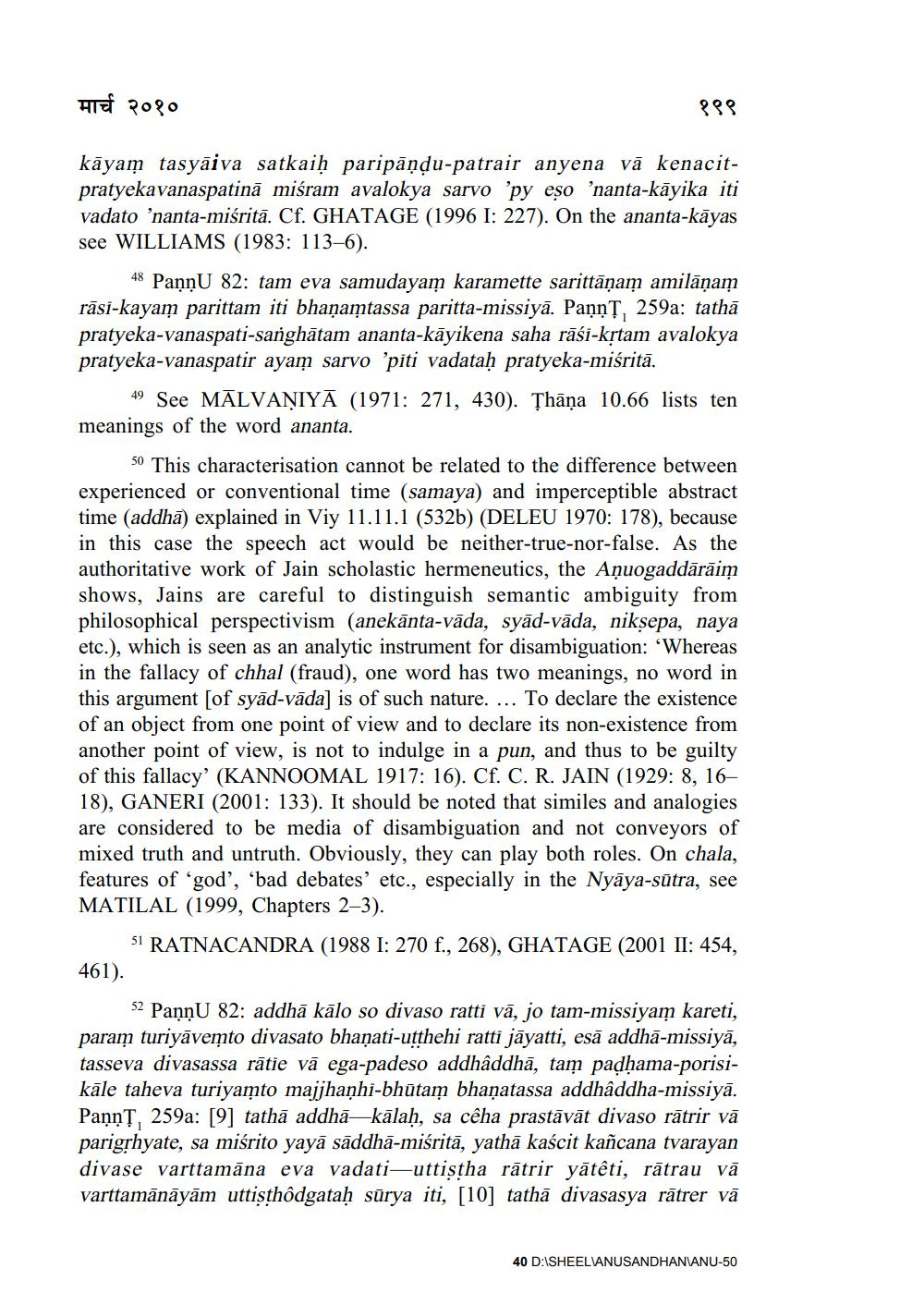________________
मार्च २०१०
१९९
kāyam tasyāiva satkaiḥ paripāņdu-patrair anyena vā kenacitpratyekavanaspatinā miśram avalokya sarvo 'py eso 'nanta-kāyika iti vadato 'nanta-misritā. Cf. GHATAGE (1996 I: 227). On the ananta-kāyas see WILLIAMS (1983: 113–6).
48 PannU 82: tam eva samudayam karamette sarittāņam amilāņam rāsi-kayam parittam iti bhaṇamtassa paritta-missiyā. Paņnī, 259a: tathā pratyeka-vanaspati-sanghātam ananta-kāyikena saha rāśi-krtam avalokya pratyeka-vanaspatir ayam sarvo 'piti vadataḥ pratyeka-misritā.
49 See MĀLVAŅIYĀ (1971: 271, 430). Thāņa 10.66 lists ten meanings of the word ananta.
50 This characterisation cannot be related to the difference between experienced or conventional time (samaya) and imperceptible abstract time (addha) explained in Viy 11.11.1 (532b) (DELEU 1970: 178), because in this case the speech act would be neither-true-nor-false. As the authoritative work of Jain scholastic hermeneutics, the Aņuogaddārāim shows, Jains are careful to distinguish semantic ambiguity from philosophical perspectivism (anekānta-vāda, syād-vāda, niksepa, naya etc.), which is seen as an analytic instrument for disambiguation: 'Whereas in the fallacy of chhal (fraud), one word has two meanings, no word in this argument [of syād-vāda) is of such nature. ... To declare the existence of an object from one point of view and to declare its non-existence from another point of view, is not to indulge in a pun, and thus to be guilty of this fallacy' (KANNOOMAL 1917: 16). Cf. C. R. JAIN (1929: 8, 16– 18), GANERI (2001: 133). It should be noted that similes and analogies are considered to be media of disambiguation and not conveyors of mixed truth and untruth. Obviously, they can play both roles. On chala, features of 'god', 'bad debates' etc., especially in the Nyāya-sūtra, see MATILAL (1999, Chapters 2–3).
SI RATNACANDRA (1988 I: 270 f., 268), GHATAGE (2001 II: 454, 461).
52 PannU 82: addhā kālo so divaso ratti vā, jo tam-missiyam kareti, param turiyāvemto divasato bhanati-utthehi ratti jāyatti, esā addhā-missiya, tasseva divasassa rātie vā ega-padeso addhâddhā, tam padhama-porisikāle taheva turiyamto majjhanhi-bhūtam bhaņatassa addhâddha-missiyā. PannŢ, 259a: [9] tathā addhā—kālah, sa cêha prastāvāt divaso rātrir vā parigrhyate, sa miśrito yayā sāddhā-misritā, yathā kaścit kañcana tvarayan divase varttamāna eva vadati-uttistha rātrir yātêti, rātrau vā varttamānāyām uttisthôdgataḥ sūrya iti, [10] tathā divasasya rātrer vā
40 D:ISHEELANUSANDHANIANU-50




